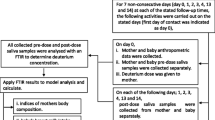Abstract
Neonatal uptake of mercury (Hg) from milk was examined in a pregnant sheep model, where radioactive mercury (Hg203)/silver tooth fillings (amalgam), were newly placed. A crossover experimental design was used in which lactating ewes nursed foster lambs. In a parallel study, the relationship between dental history and, breast milk concentration of Hg was also examined in 33 lactating women. Results from the animal studies showed that, during pregnancy, a primary fetal site of amalgam Hg concentration is the liver, and, after delivery, the neonatal lamb kidney receives additional amalgam Hg from mother's milk. In lactating women with aged, amalgam fillings, increased Hg excretion in breast milk and urine correlated with the number of fillings or Hg vapor concentration levels in mouth air. It was concluded that Hg originating from maternal amalgam tooth fillings transfers across the placenta to the fetus, across the mammary gland into milk ingested by the newborn, and ultimately into neonatal body tissues. Comparisons are made to the U.S. minimal risk level recently established for adult Hg exposure. These findings suggest, that placement and removal of “silver” tooth fillings in pregnant and lactating humans will subject the fetus and neonate to unnecessary risk of Hg exposure.
Similar content being viewed by others
References
F. L. Lorscheider, M. J. Vimy, and A. O. Summers, Mercury exposure from “silver” tooth fillings: emerging evidence questions a traditional dental paradigm,FASEB J. 9, 504–508 (1995).
L. J. Hahn, R. Kloiber, M. J. Vimy, Y. Takahashi, and F. L. Lorscheider, Dental “silver” tooth fillings: a source of mercury exposure revealed by whole-body image scan and tissue analysis,FASEB J. 3, 2641–2646 (1989).
M. J. Vimy, Y. Takahashi, and F. L. Lorscheider, Maternal-fetal distribution of mercury (Hg-203) released from dental amalgam fillings,Am. J. Physiol. 258, R939-R945 (1990).
G. Drasch, I. Schupp, H. Höfl, R. Reinke, and G. Roider, Mercury burden of human fetal and infant tissues,Eur. J. Pediatr. 153, 607–610 (1994).
G. J. Mears, G. R. Van Petten, W. H. Harris, J. U. Bell, and F. L. Lorscheider, Induction of oestrus and fertility in the anoestrus ewe with hormones and controlled lighting and temperature.,J. Reprod. Fertility 57, 461–467 (1979).
M. J. Vimy and F. L. Lorscheider, Dental amalgam mercury daily dose estimated from intra-oral vapor measurements: a predictor of mercury accumulation in human tissues,J. Trace Elem. Exper. Med. 3, 111–123 (1990).
S. A. Winfield, N. D. Boyd, M. J. Vimy, and F. L. Lorscheider, Measurement of total mercury in biological specimens by cold vapor atomic fluorescence spectrometry,Clin. Chem. 40, 206–210 (1994).
J. M. Doney, J. N. Peart, W. F. Smith, and F. Louda, A consideration of the techniques for estimation of milk yield by suckled sheep and a comparison of estimates obtained by two methods in relation to the effect of breed, level of production and stage of lactation.J. Agricultural Sci. (Cambridge),92, 123–132 (1979).
A. A. Jensen, Chemical contaminants in human milk.Residue Rev. 89, 1–127 (1983).
R. A. Lawrence,Breastfeeding: A Guide for the Medical Profession, Mosby, St. Louis, MO, p. 96 (1994).
P. Schramel, S. Hasse, and J. Ovcar-Pavlu, Selenium, cadmium, lead and mercury concentrations in human breast milk, in placenta, maternal blood and the blood of the newborn,Biol. Trace Elem. Res. 15, 111–124 (1988).
M. S. Wolff, Occupationally derived chemicals in breast milk,Am. J. Ind. Med. 4, 259–281 (1983).
U.S. Department of Health & Human Services,Toxicological Profile for Mercury, Agency for Toxic Substances and Disease Registry, Atlanta, pp. 123–131 (1994).
Author information
Authors and Affiliations
Rights and permissions
About this article
Cite this article
Vimy, M.J., Hooper, D.E., King, W.W. et al. Mercury from maternal “silver” tooth fillings in sheep and human breast milk. Biol Trace Elem Res 56, 143–152 (1997). https://doi.org/10.1007/BF02785388
Received:
Accepted:
Issue Date:
DOI: https://doi.org/10.1007/BF02785388




